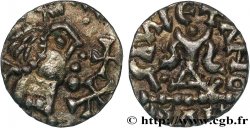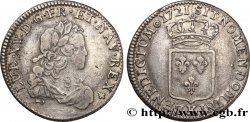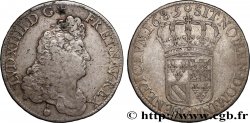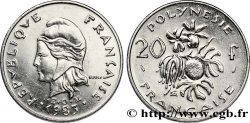bmv_269385 - MEROVINGIAN COINAGE - BANASSAC (BANNACIACO) - Lozere Triens au vase et au rameau à trois branches
недоступный.
Товар уже продан в нашем интернет-магазине (2012)
Цена: : 1 250.00 €
Товар уже продан в нашем интернет-магазине (2012)
Цена: : 1 250.00 €
Тип Triens au vase et au rameau à trois branches
Дата: 620-640
Монетный двор / Город: Banassac (48)
Металл: gold
Диаметр: 12,5 mm
Ориентация осей монеты: 11 h.
Вес: 1,13 g.
Редкость: R3
Комментарии о состоянии
Monnaie complète, de frappe vigoureuse et centrée des deux côtés. Métal de faible aloi, avec des concrétions sombres autour des reliefs. Surface avec un aspect brossé
Ссылки в каталоге: :
Лицевая сторона
Аверс: легенда: ANÉPIGRAPHE.
Аверс: описание: Tête barbare diadémée, à droite ; diadème très saillant à la tranche perlée ; calotte et bouton occipital ; devant le profil, rameau renversé à trois baies.
Обратная сторона
Реверс: легенда: GAVALETANO // BAH.
Реверс: Описание: Calice à deux anses, entre deux globules, posé sur une ligne d’exergue perlée ; légende autour et à l’exergue.
Комментарий
Ce type précis, avec le rameau à trois baies, correspond à la variété E du Belfort regroupant les monnaies B. 754-747. Toutes les monnaies de ce type ont un vase entre deux globules. Notre exemplaire a un autre globule après le G de GANETANO et un autre après le A de BAH. Selon le MONETA, ce triens correspond au groupe 12-2E pour lequel seulement 6 exemplaires ont été étudiés (les quatre du Belfort, le n° 25 d’Avignon et un exemplaire passé en vente au Crédit e la Bourse en 1994).
Le n° 423 de Cambridge a ce même avers, mais associé à la légende TELAFIVS MONETA..
Le n° 423 de Cambridge a ce même avers, mais associé à la légende TELAFIVS MONETA..








 Cообщить об ошибке
Cообщить об ошибке Распечатать страницу
Распечатать страницу Отправить мой выбор
Отправить мой выбор Задать вопрос
Задать вопрос Consign / sell
Consign / sell
 Информация
Информация














